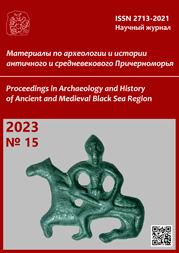Железный топор из тасмолинского кургана могильника Кызылжартас: результаты металлографического и химического анализов
Iron axe head from the Tasmola Culture barrow in the Qyzylzhartas burial ground: results of metallographic and chemical analysis
Author(s): Arman Z. Beisenov, Alexander V. Panichkin, Darkhan T. ShashenovSubject(s): History, Archaeology, Prehistory
Published by: Нижневартовский государственный университет
Keywords: Qyzylzhartas; Central Kazakhstan; Tasmola Culture; Early Saka period; iron axe head; metallographic analysis; Vickers hardness test; chemical analysis; radiocarbon date;
Summary/Abstract: In 2020, barrow 1 in the Qyzylzhartas burial ground, Karaganda region, the Republic of Kazakhstan, was excavated. The barrow of the Early Saka period had a crepidome in its base, and the mound itself had 37 m in diameter and was surrounded by a stone fence with a diameter of 56 m. Under the mound, there were three stone sculptures depicting two males and a female, while another one, representing a male, was placed in the dromos of the grave. The burial had been robbed in the past. The burial pit contained part of the bones of a human skeleton, near which over 300 small pieces of gold decoration were found. An iron axe head has 21.3 cm of length and 1.7 kg of weight and was found near the burial pit. In the spring of 2023, two bone samples were analyzed by the Laboratory of Mass Spectrometry ‘Vilnius Radiocarbon’, Lithuania. The one was a human bone found in the grave, and the other was an animal bone from a tunnel dug by robbers. Both archaeological evidence and a radiocarbon date obtained from a human bone sample suggest the 8th century BCE to be the most relevant date for the burial. It is the same time range that the massive axe head of archaic appearance, made of a piece of iron, apparently dates back to. This is the first discovery of an iron axe head of the early Saka period in Kazakhstan. In 2022—2023, metallographic and chemical analyzes of the iron tool were carried out. The results of these analyzes are published for the first time in this paper. The bits of the axe head were found to have been carburized by an ancient blacksmith in order to impart hardness onto these spots. The Vickers hardness test confirmed this observation by comparing the bits and the shaft-hole part of the axe head.
Journal: Материалы по археологии и истории античного и средневекового Причерноморья
- Issue Year: 2023
- Issue No: 15
- Page Range: 102-120
- Page Count: 19
- Language: Russian

